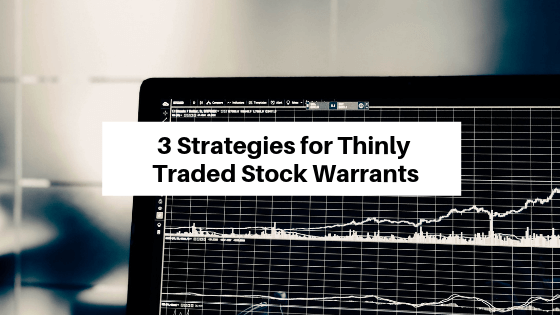
My daughter recently started using Poshmark to sell clothes she no longer wears. It’s interesting to watch her figure out the lay of the land in a new market.
As with any market, there are positives and negatives.
One of the benefits of Poshmark, as with any successful market, is that it brings together a large number of buyers and sellers.
As part of learning Poshmark, my daughter has also explored other markets for selling used clothes. At my urging, uh hum, I mean at my suggestion, she found there is a market on Instagram for these items as well. (ARBITRAGE!)
But, the trouble with Instagram is there is no ready made audience for your product until you build a following.
She is getting a firsthand education in a thinly traded market, until she builds a following.
Fortunately for stock and warrant traders, the stock market has been around a little longer than Instagram.
And, there are a few strategies you can employ to improve your chances of succeeding with a thinly traded stock warrant.
1. Use Limit and GTC Orders in Thinly Traded Stock Warrants
The first strategy is take advantage of the different types of orders you can enter in the market.
Enter a limit order in between the spread in a thinly trade warrant or stock. For example, let’s say I’m trading a stock warrant with a price under a dollar, and the spread is more than $.10.

I’ll definitely place a limit order between the spread as opposed to taking an offer or hitting a bid.
You can also take the opportunity in a wide spread to play market maker yourself. Depending on the situation, and what your goal is, you can place orders at both the bid and offer.
This gives you a chance to make the spread yourself in a stock or warrant that is trading sideways.
If you can’t watch the position every day, you can also use Good ’til Cancelled orders. These limit orders will stay on your broker’s book until you cancel it.
I generally do not use this type of order, unless it is for a small position. The risk is that the stock or warrant will move a large amount after executing your order.
If the position you are left with after execution is flat, then no problem. But if you are entering a position with the order you’ll need to pay attention to any executions.
2. Contact Your Brokerage Firm for Help in a Thinly Traded Warrant
If you can’t get a limit order execution in a thinly traded issue, you can also contact your broker.

The broker may be able to match your order with another customer.
Or, they may be able to convince their trader to take a position in the stock, if they are a market maker.
It was not unheard of for a customer to request an execution between the spread, in a thinly traded issue, when I worked as a market maker.
Of course it is at the broker’s discretion, but most full service brokers do try to keep their customers happy.
The broker may also be able to see an order in a market that is not generally accessible to the public. And this may be enough to have the order executed as well.
3. Contact the Issuer of the Thinly Traded Warrant or Stock
If all else fails, you can contact the stock or warrant issuer.
The issuer may be able to direct a cross of your order with a known seller or buyer of the stock or warrant.
Of course this may depend on the size of your order and where you would like to execute it relative to the market. But, it never hurts to ask.
Bonus Pro Tip – Thinly Traded Stock Warrant Arbitrage
Finally, depending on the size of your account (large) and the way you trade (hedged positions), you may have the option to cross an entire position where there are thinly traded stock warrants.
Let’s say you have a warrant and common that generally trade at a $.15 to $1.00 premium. You are able to put on a the position, short common and long warrants at the $.15 premium.
But, you don’t want to tie up capital any longer than you absolutely must, so you can offer to sell your position at a higher premium, less than $1.00.
For example, you can offer to sell your position. This means you would buy common and sell warrants, to another party for a $.40 premium. You make the $.25 difference between $.15 and $.40.
And, the other party now has the opportunity to make something between $.40 and $1.00.
You can use this strategy even in non-thinly traded markets, but you’d likely need to have the premium at at least $.40 (and maybe higher) to sell the position to another party.
Otherwise, obviously, the other party could put on the position themselves.
Conclusion
I hope this helps for those of you who’ve been asking about thinly traded warrants. It is definitely a hurdle to overcome in some thinly traded stock warrants, but should not deter you from warrant trading in general.
Another way to look at it is there is less competition for arbitrage in a thinly traded issue.